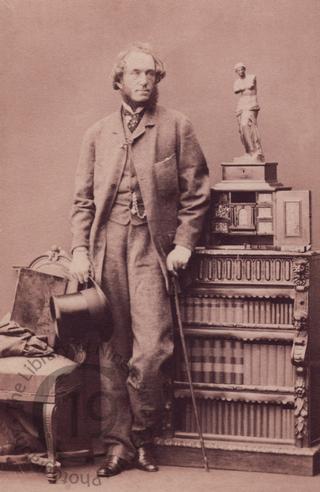
John Leech
A carte-de-visite portrait of the illustrator John Leech (1817-1864).
John Leech was born in London on 29 August 1817, the son of a coffee-house proprietor. He was educated at Charterhouse and at the age of sixteen he began to study medicine at St Bartholomew's Hospital. The superb artistry of his anatomical drawings led to commissions to paint his teachers' portraits. Leech soon left medical school and tried to make a living from drawing and painting. His first known published work is a pamphlet entitled Etchings and Sketchings (1835) which included drawings of street characters such as cabmen, policemen, and itinerant musicians. For the next few years Leech produced various humorous pamphlets including The Comic Latin Grammar, The Fiddle-Faddle Fashion Book and The Children of Mobility. Although influenced by the work of James Gillray and George Cruikshank, Leech's humour was considered, by one critic at least, 'less grotesque, less boisterous, less exaggerated, nearer to the truth and to ordinary experience'.
In 1840 Leech was employed as an illustrator by the London Magazine. The following year he was recruited by Punch, a new journal founded by Mark Lemon and Henry Mayhew. Leech's humorous drawings were extremely popular and his work was one of the principal reasons for the magazine's great success. Over the next twenty-three years Punch published 3,000 of Leech's drawings and 600 of his cartoons. A significant percentage of those drawings dealt with political issues. Like the editors of the magazine, Lemon and Mayhew, Leech held fairly radical views. Between 1842 and 1845 Leech produced a series of cartoons such as Capital and Labour, Cheap Clothing and The Agricultural Question, which questioned the morality of the capitalist system. In the cartoon Substance and Shadow (1843), Leech criticised artists for ignoring social issues such as poverty.
Leech sympathized with those arguing for universal suffrage. However, like most liberals, he strongly opposed the arguments put forward by Feargus O'Conner and the Chartists. Leech was one of the 150,000 special constables recruited in April 1848, when the Chartists held their large demonstration at Kennington. The following week a section of the magazine was devoted to the Chartist rally. One drawing, showing a special constable who cannot remember if he supports or opposes the Chartists, probably reflects Leech's own views.
As well as providing drawings for Punch, Leech worked for several other publications including Bentley's Miscellany where he met Charles Dickens. As a result of this meeting Leech provided the drawings for Dickens's A Christmas Carol.
In middle age Leech suffered from angina and had to give up strenuous exercise. He also reduced his output of drawings. John Leech died of a heart attack at the age of 47 on 29 October 1864. He is buried in Kensal Green Cemetery, London.
'The keynote of his character, socially, seemed to be self-effacement, high-bred courtesy, never failing consideration for others. He was the most charming companion conceivable [...] He was tall, thin, and graceful, extremely handsome, of the higher Irish type, with dark hair and whiskers and complexion, and very light greyish-blue eyes; but the expression of his face was habitually sad, even when he smiled. In dress, bearing, manner, and aspect he was the very type of the well-bred English gentleman of the world and good society' (George Du Maurier, quoted in The Life and Letters of Sir John Everett Millais, 1899).
Photographed by Camille Silvy of London on 16 July 1861.
Code: 124140




